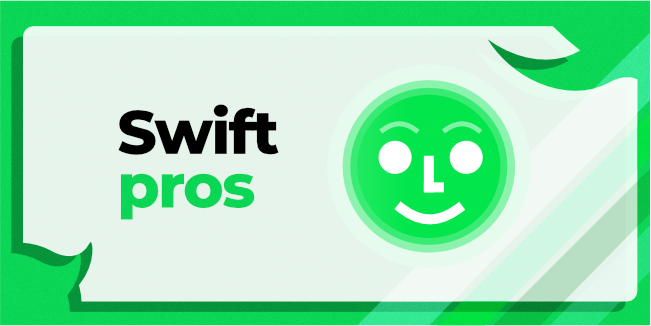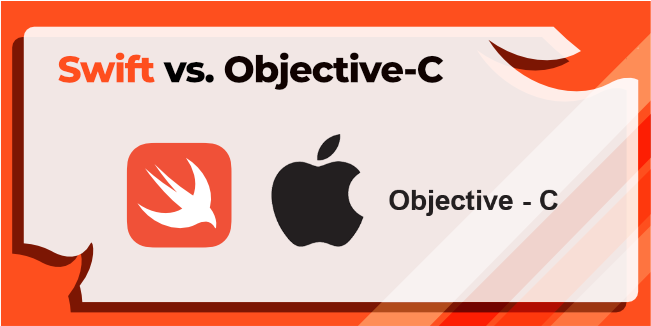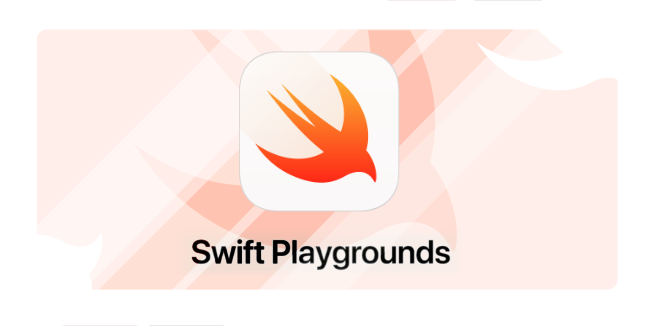Mobile Development
Technologies
swift
programming
languages
Is Swift Programming Language Any Good? Pros and Cons

Do you know how the preferences of mobile users in the United States differ from those elsewhere in the world? According to Statcounter, Android has a global market share of around 72.7 percent, whereas iOS has a global market share of about 26.4 percent. However, if we consider the US map, iOS is ahead with 56.7 percent. That's a huge market to hit on.
Given the numerous individuals' unyielding devotion to Apple devices, iOS app development is more essential than ever. You must pick the appropriate technology stack for your product. If you opt for native instead of cross-platform solutions, you'll have to select between Objective C and Swift, which are both new.
What is Swift?
Swift is a multi-paradigm, general-purpose, open-source programming language designed especially for iPadOS, macOS, tvOS, watchOS, and iOS development. Apple created the Swift programming language in 2014 to provide developers with a powerful tool for developing iOS applications.
The goal of the language was to be safe, quick, and expressive, according to swift.org. It's intended to take the place of C-based languages. Swift is continuously evolving and gaining in popularity among users. The source code for Swift may be found on GitHub, making it simple for anybody to access.
The syntax and standard library have been created with the goal of ensuring that the most natural style to write your code achieves the best performance. Its safety and speed make Swift an excellent choice for all types of applications, from "Hello, world!" to a full operating system.
History of Swift
Since its debut at Apple's 2014 Worldwide Developers Conference (WWDC), the Swift programming language has generated a lot of discussions.
Chris Lattner, Apple’s Senior Director, Developer Tools Department, started designing the basic concepts of the new language back in 2010.
“Initially, it was really just me messing around and nobody knew about it because it wasn’t anything to know about. But eventually, it got a little bit more serious […] So I started talking to my management and some of the engineers that were working on Clang, and they seemed excited about it. We got a couple people working on it part-time and I convinced my manager that it was interesting enough that we could have a couple of people work on it.” – Chris Lattner for Accidental Tech Podcast, January 2017
After that, in 2013, the team was able to answer a strategic question regarding how the new language would fit in with the existing Objective-C ecosystem. All iOS developers might have been forced to change their languages if they were required to do so. As a result, rather than forcing all iOS developers to move to a new language, the firm decided to continue investing in Objective-C while also committing to the development of a new "safe programming language."
Apple's first announcement of the new programming language was made one year after its introduction as a part of Xcode tools. According to Tim Cook, it was downloaded over 11 million times in the first month following its release as a component of Xcode tools.
The reactions to Swift were largely negative at first. Some developers praised its capabilities, flexibility, and ease of use, but others condemned it. However, most people agreed that it was too soon to put Swift into production. The language was changing rapidly: with each new release, substantial modifications were made.
Swift Pros

Swift is a relatively new programming language that was designed to improve on the shortcomings of Objective C. Swift is often referred to as "Objective-C without the C." In many ways, it outperforms its predecessor. Swift combines the performance and efficiency of compiled languages with the simplicity and interactivity of popular scripting languages, according to the official press release. Let's forget about technology specifics and marketing for a moment and analyze what this means from a business standpoint.
Rapid Development Process
Swift is more readable than other programming languages with a simplified syntax and grammar. It's shorter, which means less code is required to achieve the same result as compared to Objective-C. Automatic Reference Counting (ARC) takes care of all of the memory monitoring and management; therefore, developers don't have to do it manually. As a result, Swift-based iOS apps are typically built in less time than their Objective-C counterparts.
The iOS app of Lyft is a great example of when writing in Swift can help you get ahead: The firm completely re-wrote its iOS application in Swift. While the previous codebase contained about 75,000 lines of code, the new version provided nearly identical functions with less than a third of that. In addition, the launch process for the app was enhanced: while the old one required more than a month and several engineers to build.
Interactive
You may use a Swift code to create a product that is future-proof and can be expanded upon as needed. As a result, Swift projects are often easier to scale. The reality that Apple is more likely to aid Swift than Objective-C should be weighed carefully. Furthermore, if you need additional developers, you may add them pretty quickly: due to the simplicity and brevity of the codebase, the onboarding process is quite fast.
Fast and Safe
Swift Language is, as the name implies, made to be fast. The language was initially created to outperform its precursor in terms of performance and speed. In particular, the initial release boasted a 40% improvement in performance over Objective-C.
In addition, Swift was created on the LLVM compiler framework, which converts assembly language to machine code and optimizes the code for you.
Over time, many different developers have validated that. Furthermore, there are a variety of methods to improve the performance of Swift code.
Another benefit of Swift Language is its safety. The strong typing system and error handling in Swift prevent code crashes and problems in production. As a result, Swift has a shorter feedback loop, allowing you to identify and repair errors immediately rather than waiting for reports to come in and fixing problems on the go, reducing the time and work needed for bug fixing.
Full Stack Potential and Cross-Device Support
The use of cloud-based languages has been a great success for IBM. The initiative to move the language to the cloud has so far been very successful, with server-side Swift interacting with the most popular backend systems. Server-side Swift integrates with a variety of backend technologies, much like full-stack Javascript development does. Using Swift on both the backend and frontend of your app can speed up development by allowing for extensive code sharing and reuse, as well as lowering development costs.
Another advantage is that Swift can be used to create apps for all Apple devices, including the Apple TV, Apple Watch, and Mac. Furthermore, because of its support for multiple platforms, it may also be utilized to develop Android apps. Apart from that, there is already Linux support and a desire to bring it to the Windows platform. There were even some rumblings that Google would replace Java with Swift as a primary language for Android development after their recent I/O presentation. However, the current Google I/O statement indicates that Kotlin will be Android's future.
Swift Package Manager
The Swift Package Manager is a package management system for the Swift compiler. It automates the download, compilation, and linking of dependencies using the Swift build system.
Open-source Swift Community
Apple Senior VP of Software Engineering, Craig Federighi, said it this way: “We saw open sourcing as a critical element to make Swift reach its potential to be the language, the major language for the next 20 years of programming in our industry.”
Indeed, Swift has established one of the most active and vibrant open source communities owing to Apple's and IBM's strong corporate backing. The case in point is the growth patterns mentioned previously. In addition, on GitHub, Swift is now the most popular language, followed by Google's Go.
Swift Cons

While there are several reasons to enjoy Swift, the language is still far from perfect. When it comes to adopting a new language, many developers and business owners have a negative attitude. There are a few causes for that.
"Moving Target”
It's no secret that Swift is a bit of a wild horse. Despite this, it should be noted that it has an extremely large number of bugs and stability issues associated with its frequent updates. According to many developers, one of the most significant difficulties is the lack of backward compatibility across language versions. As a result, if you want to move to the newest Swift version, you'll have to rewrite your project entirely.
While Xcode provides a tool to help developers update their Swift code to newer versions, it doesn’t fix all the issues. Thus, porting your project to a newer Swift version can be time-consuming and costly. If you have a very large project or a project that you don’t plan to update too often, Swift might be not the best option for you, at least for now.
Young Language
Swift was unveiled to the public in 2014, yet the language is only seven years old, compared to existing Objective-C living since the 1980s. The most recent upgrade included ABI stability across Apple's platforms, Swift version backward compatibility, and updated documentation. Those are significant steps toward making Swift a more mature language.
However, these steps, such as frequent updates and changes, frequently cause developers to doubt if their current code will be compatible with future versions and whether it can even be compiled.
Limited Talent Pool
While the Swift community is gaining steam, it remains significantly smaller than most other open-source languages. Only 6.5 percent of the 64,000 respondents in the latest StackOverflow Developer Survey use Swift, according to Upwork.com, a worldwide freelancing marketplace.
There are not many Swift coders around, and even fewer of them have significant practical experience with the language. There's only one individual who has such knowledge of Swift, but Tesla has already recruited that player for their team.
Incomplete Cross-Platform Support
Only apps that target iOS 7 and later may use Swift. That said, because of its architecture, Swift cannot be used in legacy projects running on previous versions of the operating system. However, according to recent study results, less than 5% of Apple devices now run on iOS 8 or earlier. Incomplete cross-platform support As we mentioned earlier, Swift supports all Apple platforms, as well as Linux and Windows. However, it was originally created and still works best for iOS native development, leaving the cross-platform development market to React Native, Xamarin, and Flutter.
Lack of Backward Compatibility
Only apps that specifically target iOS 7 and later may utilize Swift. That said, legacy applications running on earlier versions of the operating system are not allowed to use Swift. It's not really a big deal since only a tiny percentage of Apple devices run on iOS 6 or earlier versions today, but you should keep it in mind just in case you are wondering if it will work on your next Swift project.
Swift vs. Objective-C

Choosing between programming languages is largely a question of your team's experience and preferences. If your developers are skilled in Objective-C, shifting them all to Swift may not be an option. Furthermore, although Swift offers frequent updates and compatibility with modern tools, it also has a large code base, third-party libraries, and tools from which it inherited. So let's look at when you should stay Objective-C over Swift.
Maintaining an Objective-C App
If you have to maintain a functioning application that is written in Objective-C and has a substantial code base, it just doesn’t make sense to rewrite it in Swift.
Old OS Versions Support
Being a new language, Swift supports only iOS 7 and macOS 10.9 or higher. If you have a reason to build or maintain apps that should run on older versions, you don’t have any other choice rather than using Objective-C.
Tight Deadlines
Learning a language, as simple as Swift, takes time and effort that many development teams lack. If you don't have the option of delaying your app release until your team is fluent in Swift, sticking with Objective C may be the best option. In case you have more time on your hands, learning Swift would be advantageous in the long run since Apple has no plans to discontinue it. A clean and expressive language with a simplified syntax and grammar, Swift is easier to read and write.
Big Project Size
Swift is relatively new, which is why small programs may avoid updates much easier. We mentioned in the drawbacks that modifying your program with each version release may be a hassle, so you shouldn't risk large lists of modifications until this problem is fully addressed.
Using C or C++ third-party Frameworks
As a superset of C, Objective-C allows you to utilize C and C++ libraries with ease and grace. Although importing just C++ modules is unusual, be aware that Swift does not support it. To utilize the C++ code, an Objective-C or C wrapper must be created between Swift and C++.
Swift Playgrounds

You may get started learning Swift by determining if it is beneficial or harmful to your career. You may inquire whether there are many methods to learn it. Because of its open-source nature, Swift has grown in popularity and the number of platforms on which it can be learned. We've already mentioned a few of them, but let's compile all the information we have about them here.
The best approach to acquiring technical understanding and learning how to code in Swift in a fun and instructive manner is with the Swift Playgrounds.
Swift Playgrounds is a development environment integrated into Xcode on MacOS, or it may be downloaded as an app for the iPad. It's basically a training course that teaches you how to code with Swift interactively. With Swift Playgrounds you can:
- Share your creation with friends
- Take things to Xcode. And back again
- Share it with the world on the App Store
Why use Swift For Next Projects?
A major advantage of Swift is that it can operate both the client and server-side of development, allowing it to have an impact on user experience, transaction capability, and security. Because Swift Source Code may be simply imported across various platforms, devices, and usage scenarios, it has the potential to move the client as well as the server-side of development. By default, Apple Platforms come with an Objective-C runtime that is needed to access Apple Platform Frameworks like UIKit and AppKit. This isn't true for other platforms.
Swift Libraries
The Standard library, which comes with Swift, is quite extensive and includes all of the features needed to create apps in Swift. This library allows developers to "solve hard problems and write high-performance, readable code" according to Apple's documentation.
Furthermore, there is a Swift Libraries project that provides a higher degree of functionality and includes a comprehensive range of APIs that are consistent across platforms. As a consequence, the code will be portable to all platforms supported by Swift.
SwiftUI
In a nutshell, SwiftUI is a full-fledged UI framework that can be used on Apple platforms. It debuted in 2019 as part of XCode 11 and was created to replace UIKit and AppKit with improved performance and ease of use.
Since it is still relatively new, SwiftUI has a few issues and flaws. It lacks API coverage compared to that of UIKit, but it continues to expand and is expected to become the main interface tool in iOS app development. It now provides full UIKit and AppKit interoperability, allowing you to use SwiftUI in your existing project if desired.
Conclusion
Despite its tender age and the debate that has surrounded it, Swift already has a number of outstanding success stories. Lyft, LinkedIn, Coursera, Pandora, Vimeo, Twitter, Fitbit, and Groupon are among the businesses that have adopted the new language. Furthermore, Facebook and Uber have expressed strong interest in Swift according to reports.
With the new, better-behaved version of Swift anticipated to be released later this year, a number of the listed problems will hopefully be addressed. As a result, Swift adoption will continue to rise, which may lead to its complete displacement as the leading first-class language for native iOS development.
If you would like to build your own Swift-based application, the best way to do it is to contact an experienced mobile app development company such as mDevelopers!